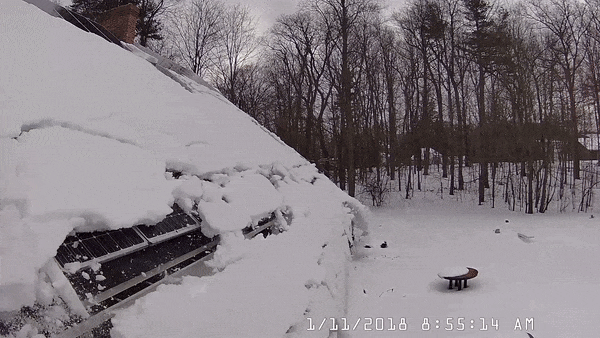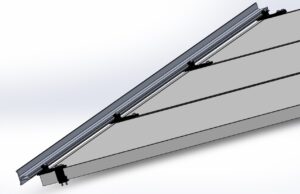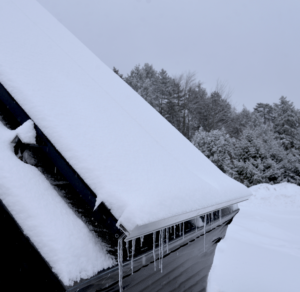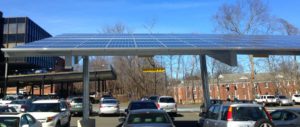Last week, we covered Snow Guards for Solar Panels, and since that post, several questions and comments have come up regarding the pros and cons of managing snow and ice on solar panel arrays.
Avalanching Snow on Solar Panels
I’ve always been a strong advocate for not using snow retention devices unless they’re needed. If there isn’t a problem, there’s nothing to worry about. In the case of the release of snow and ice from solar panels, a big problem has presented itself. The problem is that snow and ice typically accumulate on solar panels overnight, when the panels are not operating/collecting. As snow begins to melt off the upper edges of the panels, the melt water is pulled down by gravity to the glass surface of the panel. This creates a frictionless surface. Without friction to help hold back snow and ice, that mass will shoot off the panels in the form of an avalanche.

This is becoming such an important topic. At least 80% of the roofs in snow country that are residential construction projects, are traditionally composition shingle roofs. Composition shingles, by virtue of their granular surface, are resistant to snow and ice slides. Although it does happen once or twice a year, typically during sudden and sustained melting.
Pros & Cons of Managing Snow and Ice on Solar Panel Arrays
To illustrate my point, let’s say a person has owned a house with a composition shingle roof for five years. They’ve experienced five seasons of winter conditions and are feeling carefree as it relates to snow sliding off the roof. I think most homeowners would agree they recognize it can happen, but it rarely does. And when it does, it’s typically slow-moving and not avalanche-like in nature. Let’s say that same homeowner has solar panels installed on top of the composition shingles. Suddenly, and often unexpectedly, a new problem is created. Yes, you’re doing the right thing having an alternate source of renewable energy installed on your roof. But now, a problem has been created that needs to be managed in any area where people, pets, cars, patio furniture, landscaping etc. can be hit and/or hurt.
Protect People & Property
The pros seem pretty self-explanatory: manage snow and ice to mitigate a roof avalanche (and the liability that comes along with it) without adding significant cost to the project. The objective is to protect any person or property from the unexpected avalanche.
When it comes to solar snow management, probably the most common question we field here at Alpine SnowGuards relates to the function and overall efficiency of the panels. We’re often asked, “Why would I want to hold snow on my panels and reduce efficiency?”
The answer is simple; you probably don’t want to, but you may need to. That’s why we developed the only solar snow management system on the market to be low-profile enough that the safety benefits outweigh the very minimal shading that will occur with the installation of solar snow guards.
Safety Benefits Outweigh Minimal Shading
Take a look at our Solar SnowMax Shade Angle Analysis for more info on panel shading.
The low profile Solar SnowMax Universal is a key component of Alpine SnowGuards’ solar snow management system – the first and only system of its kind.


Snow and Ice on Solar Arrays Behaves Differently
We’ve found that snow and ice on solar arrays behaves differently than the same mass on an adjacent composition shingle roof. As snow begins to melt from the panel surfaces, it causes the frictionless phenomenon described above. In addition, we’re now seeing two new phenomenon that are not typical in the snow retention business:
1. Snow & Ice Melt Much Quicker on Solar Panels
As snow and ice begin to clear from the surface of the panels, the panels begin to generate electricity. This electrical generation creates heat that any adjacent, non-solar roof surfaces won’t experience. The heat tends to help clear snow and ice from the surface of solar panels much quicker than areas with composition shingle roofing.
The takeaway: snow retention devices help manage the sudden avalanche phenomenon. But, snow and ice seem to clear from the panels much quicker than expected due to heat generated from the solar panels.
2. Fence/Pipe Style Snow Guards are Best Means of Snow Management
Alpine believes that fence/pipe-style snow guards are the best means of snow management, regardless of the roof type. Fences are typically thought of as barricades on most roof surfaces. On solar arrays, fences are often functioning more as a deterrent as opposed to a barricade. (This is also typical of pad-style snow guards – you can read more about that here).
This is due in part to the frictionless characteristics of the glass and the limited height of the fence itself. One of the limiting factors with snow guard design is height. The fence for a solar array can’t be too tall or it will shade the panel. (We’re seeing similar events with some of the newer synthetic/plastic-based shingles).
Prevent Panel Shading
It’s important to manage snow and ice releases and it’s critical to prevent shading of a panel once the snow and ice has cleared. As panels clear and heat up, the melt process happens at a faster rate than the melt process on adjacent composition shingle roof surfaces, described above. The snow mass will begin to slump against the fence, and due to the limited height, will sometimes crest like a wave, coming up and over the top of the snow guard. This is often referred to as a “cornice” in the avalanche world, a moving crest being pushed by hydraulics and pulled by gravity.
The takeaway: Snow and ice releases from solar panels can be deterred, much like with pad-style snow guards, although it’s highly unlikely that they can be barricaded as they would be with typical rooftop fence-style snow guards.
One Tier of Solar Snow Guards May Not Be Sufficient
The quantity of solar snow guards needed for a project is another question we get asked a lot. Alpine has been in the snow management business since 1993, and we’re happy to assist and recommend layouts and quantities. However, it’s important to point out that this snow management problem on solar arrays is a new problem, in a relatively new industry. As Alpine collects more data and develops better solutions, we’ll adjust our expectations, as well as our recommendations accordingly. At a minimum, it’s important to understand that one tier of snow guards installed along the leading edge of an array may not be sufficient enough to manage an array with multiple tiers of panels.
Speaking of the possibility of needing additional tiers of solar snow management, we’ve been asked, “If holding snow and ice on the array will add weight to the system.” It won’t.
Each array is designed to function structurally given the local building design loads for wind and snow. Having snow guards installed will not add any weight that the building engineer has not already calculated into the structural design. Having said this, whether your array has snow guards or not, it’s important to clear off any snow or ice that may accumulate below the leading edge of an array (assuming there are specified setbacks at the eaves).
As the array sheds, either water or wet snow and ice will slide off the butt of the array. If this mass accumulates enough that it begins to build up on the roof and climb back onto the panels, it’s possible that the weight could bend the leading edge of the lowest row of panels.
Solar Carports & Canopies
As a final thought, consider the solar carports and canopies that are being installed in many North American snow country locations. There was once only the issue of scraping snow and ice from your windshield upon returning to your car. There was no worry about the mass of snow that has accumulated on a rooftop above you. A carport to protect your car means you no longer need to scrape the windshield! Perfect, right? Let’s hope you still have a windshield if the snow mass above releases as you exit the parking structure.

Bottom line: Protect people. Protect property.
Until next time,
Brian Stearns
President & Founder, Alpine SnowGuards
We keep snow in its place
888.766.4273
Sign up to start using our Online Project Calculator for an immediate layout and project pricing!
Subscribe to our monthly newsletter and keep up on the latest industry and Alpine news, products, and upcoming events!
Alpine SnowGuards designs, engineers, and manufactures snow management systems from our facilities in Morrisville, VT. We work closely with leading roofing contractors, engineering firms, developers, and roofing manufacturers to ensure we deliver quality products that do what we say they’ll do. Alpine SnowGuards can help a building qualify for LEED® credits.
